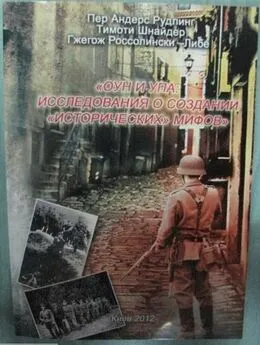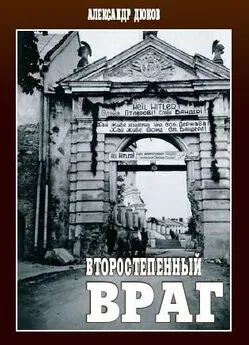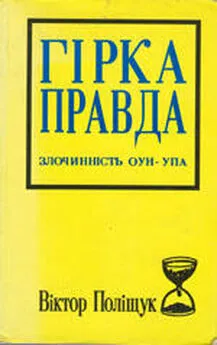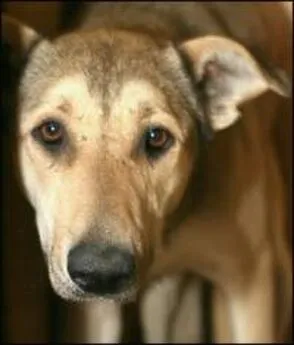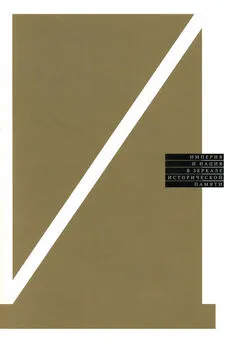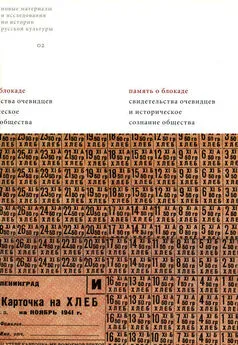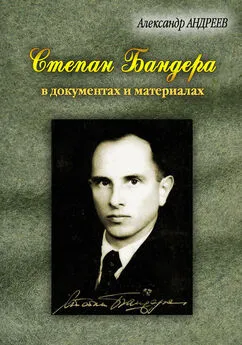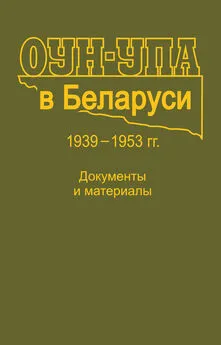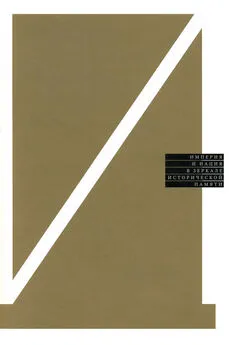Пер Рудлинг - ОУН и УПА: исследования о создании исторических мифов. Сборник статей
- Название:ОУН и УПА: исследования о создании исторических мифов. Сборник статей
- Автор:
- Жанр:
- Издательство:Золотые ворота
- Год:2012
- Город:Киев
- ISBN:978-966-2246-16-2
- Рейтинг:
- Избранное:Добавить в избранное
-
Отзывы:
-
Ваша оценка:
Пер Рудлинг - ОУН и УПА: исследования о создании исторических мифов. Сборник статей краткое содержание
Сборник статей «ОУН и УПА: исследования о создании «исторических» мифов» является вторым изданием в серии «Историческая правда», основанной Международным антифашистским фронтом в 2011 году.
В издании представлены исследования современных западных ученых — Пера Андерса Рудлинга, Тимоти Д. Шнайдера, Гжегожа Россолинского-Либе на тему украинского радикального национализма, фашизма, создания антиисторических мифов вокруг ОУН-УПА, преступлений против человечности, попыток героизации и реабилитации этих организаций и их членов.
Большинство исследований в Украине публикуются впервые.
ОУН и УПА: исследования о создании исторических мифов. Сборник статей - читать онлайн бесплатно полную версию (весь текст целиком)
Интервал:
Закладка:
Ibid., ll. 1–3. For Sheptyts'kyi's pastoral letter, see OUN v svitli postanov Velykykh Zboriv (s.l.: Zakordonni chastyny Orhanizatsii Ukrains'kykh Natsionalistiv, 1955), 58.
507
For an OUN-B instruction to erect triumphal arches, see TsDAVOV f. 4620, op. 3, spr. 379, l.34 (Instruktsiia propahandy, ch. 1). For pictures and descriptions of triumphal arches, see V. Cherednychenko, Natsionalizm proty natsii (Kyiv: Politvydav Ukrainy, 1970), 93; Grelka, Die ukrainische Nationalbewegung, 256; Archiwum Wschodnie (AW) II/737, l.25; and the cover of Aleksandr Diukov, Vtorostepennyi vrag: OUN, UPA i reshenie "evreiskogo voprosa" (Moscow: Regnum, 2008).
508
BA Berlin-Lichterfelde: R 58 (Reichssicherheitshauptamt)/214, Ereignismeldungen UdSSR, Berlin, 17 July 1941, no. 25, l. 202.
509
TsDAVOV f. 4620, op. 3, spr. 379, l. 34.
510
TsDAVOV f. 3833, op. 1, spr. 15, l. 4 (Zvit pro robotu v spravi orhanizatsii derzhavnoi administratsii na tereni Zakhidnykh oblastei Ukrainy). For a photo of Sheptyts'kyi with a swastika badge on his coat during the revolution, see B. E Sabrin, Alliance for Murder: The Nazi-Ukrainian Nationalist Partnership in Genocide (New York: Sarpedon, 1991), 172.
511
TsDAVOV f. 3833, op. 1, spr. 45, l.3. By claming that he "saw Bandera twice under the gallows unconquerable and loyal to the idea," Klymiv meant the trials against the OUN in 1935-36 in Warsaw and in 1936 in L'viv, at which Bandera was sentenced to death but was said not to have expressed any fear. At the second trial the death penalty was changed to life imprisonment.
512
The picture of a German officer and two men in plain clothes at the podium is printed in Cherednychenko, Natsionalizm praty natsii, 93. For the date of this event, see TsDAVOV f. 3833, op. 1, spr. 15, l. 15.
513
TsDAVOV f. 3833, op. 1, spr. 22, ll. 1–3.
514
Ibid., op. 3, spr. 7, l. 26.
515
Ibid., op. 1, spr. 10, l. 4 (A list of deputies of the Ukrainian government abroad).
516
BA Berlin-Lichterfelde, R 58/214, Ereignismeldungen UdSSR. Berlin, 4 July 1941, no. 12, I. 69. On the Council of Seniors, see also TsDAVOV f. 3833, op. 1, spr. 15, l.3.
517
On all the projects of the state apparatus drafted by Stepaniak, see Gosudarstvennyi arkhiv Rossiiskoi Federatsii (GARF) f. R-9478 (Glavnoe upravlenie po bor'be s banditizmom MVD SSR), op. 1, d. 136, ll. 14–15. On Stepaniak's communist activities in the 1930s, see ibid., l. 10.
518
TsDAVOV f. 3833, op. 1, spr. 9, 11. 1, 3 (Copy of the minutes of the meeting of the Administration of Ukraine). Ukrainian postavyty spravupo nimets "ky. Ibid., 1.1. For a very similar statement about dealing with the "non-Ukrainians" in "Ukraine," see ibid., spr. 69, 1.36.
519
On the pogroms in western Ukraine, see Dieter Pohl, "Anti-Jewish Pogroms in Western Ukraine-A Research Agenda," in Shared History-Divided Memory: Jews and Others in Soviet-Occupied Poland, 1939–1941, ed. Elazar Barkan, Elizabeth A. Cole, and Kai Struve (Leipzig: Leipziger Universitatsverlag, 2007), 305-13; and Gabriele Lesser, "Pogromy w Galicji Wschodniej w 1941 r," in Ternary polsko-ukrainskie, ed. Robert Traba (Olsztyn: Wspolnota Kulturowas Borussia, 2001), 103-26. Similar waves of pogroms also broke out shortly after the start of the German-Soviet war in northeastern Poland and in Lithuania. For pogroms in Poland, see Andrzej Zbikowski, "Pogroms in Northeastern Poland-Spontaneous Reactions and German Instigations," in Shared History-Divided Memory, 315-54. For pogroms in Lithuania, see Christoph Dieckmann, "Lithuania in Summer 194l-The German Invasion and the Kaunas Pogrom," in Shared History-Divided Memory, ed. Barkan, Cole, and Struve, 355-85.
520
The pogrom started on 30 June 1941 or even before. For testimonies that date the beginning of the violence to 1 July 1941, see Kurt I. Lewin, Przezytem: Saga Swietego Jura spisana w roku 1946(Warszawa: Zeszyty literackie, 2006), 56–57; and ZIH 229/54, Teka Lwowska, 1.2. For the course of the pogrom in L'viv, see Christoph Mick, "Ethnische Gewalt und Pogrome in Lemberg 1914 und 1941," Osteuropa 53, 12 (2003): 1810-11, 1824-29; Hannes Heer, "Einubung in den Holocaust: Lemberg Juni/Juli 1941," Zeitschrift fur Geschichtswissenschafi 49 (2001): 410, 424; Bruder, Den ukrainischen Staat erkampfen oder sterben, 140-50; Grelka, Die ukrainische Nationalbewegung, 276-86; Dieter Pohl, Nationalsozialistische Judenverfolgung in Ostgalizien 1941–1944: Organisation und Durchfuhrung eines staatlichen Massenverbrechens (Munich: Oldenbourg, 1997), 60–62; and Wachs, Der Fall Theodor Oberlander (1909–1998), 71, 78–80. For posters and other OUN-B propaganda in L'viv during the pogrom, see Jan Rogowski, "Lwow pod znakiem swastyki: Pamietnik z lat 1941–1942" (unpublished manuscript) in Zaklad narodowy im. Ossolinskich in Wroclaw, 16711/II, 10; Lewin, Przezylem, 65; Eliyahu Yones, Die Strasse nach Lemberg: Zwangsarbeit und Widerstand in Ostgalizien 1941–1944 (Frankfurt am Main: Fischer Taschenbuch, 1999), 18; and Diukov, Vtorostepennyi vrag, 47–52. According to Diukov, some soldiers of the Nachtigall battalion participated in the violence in L'viv as well (Vtorostepennyi vrag, 71–72). Eyewitnesses saw soldiers from the Nachtigall battalion beating Jews on 1 July in the yard of the prison on Zamarstynivs'ka Street (AZIH, 30/12242, Zygmunt Tune, 1; Lewin, Przezytem, 61).
521
Mick, "Ethnische Gewalt und Pogrome in Lemberg 1914 und 1941," Osteuropa 53, 12 (2003): 1825. During this pogrom, 4,000 Jews were killed. In addition, on 5 July, between 2,500 and 3,000 Jews were shot by the German task forces. Cf. Pohl, Nationalsozialistische Judenverfalgung in Ostgalizien 1941–1944, 61, 69. Between 25 and 28 July 1941 another pogrom, dubbed the "Petliura days," occurred in L'viv. Several hundred Jews were killed, mainly by Ukrainian militiamen and Ukrainian peasants who came to L'viv from adjacent villages to take part in the violence. Cf. AZIH, 301/230, Jakub Dentel, 2; AZIH, 301/1864, Salomon Goldman, 5; AZIH, 301/4654, Henryk Szyper, 11; AZIH, 301/1584, Izak Weiser, 1; AZIH, 302/26, Lejb Wieliczker, 21; AZIH, 301/4944, Jan Badian, 1–6; AZIH, 301/1117, Leonard Zimmerman, 1; AZIH, 301/1801, Henryk Baldinger, 1–4; and AZIH, 301/2278, Lucyna Hallensberg, I.
522
Dieter Pohl, "Anti-Jewish Pogroms in Western Ukraine," in Shared History-Divided Memory, ed. Barkan, Cole, and Struve, 306.
523
TsDAVOV f. 3833, op. 2, spr. 1, l.32.
524
Ibid., ll. 62, 64. All Ukrainian men between 18 and 50 who were obliged to join the militia were to have been divided into professional militiamen who were employed full-time and reserve forces ("volunteer members"-chleny-dobrovol'tsi) who earned a living elsewhere but could be mobilized at any time.
525
Ibid., l.62.
526
For the activities of the Ukrainian militia during the pogrom, see Yones, Die Strasse nach Lemberg, 18–19; AZIH, 301-1809, Jaroslaw Korczynski (Zeznania ocalalych Zydow), 1; AZIH, 301/4654, Henryk Szyper, 6; AZIH, 301/1864, Salomon Goldman, 1; AZIH 229/22, Maurycy Allerhand (Teka Lwowska), 1; and AZIH: 229-54, Teka Lwowska, 1. For general accounts of the Ukrainian police forces during World War II in Ukraine, see Dieter Pohl, "Ukrainische Hilfskrafte beim Mord an den Juden," in Die Tater der Shoah: Fanatische Nationalsozialisten oder ganz normale Deutsche? ed. Gerhard Paul (Gottingen: Wallenstein, 2002), 202-34; and Gabriel N. Finder and Alexander V. Prusin, "Collaboration in Eastern Galicia: The Ukrainian Police and the Holocaust," East European Jewish Affairs 34, 2 (2004): 95-118. For information on German assistance in anti-Jewish measures, see Patryliak, Viis "kova diial "nist" OUN (B) u 1940–1942 rokakh, 232.
527
TsDAVOV f. 3833, op. 2, spr. 1, ll. 60, 62.
528
On the antisemitism of the OUN-B leader Iaroslav Stets'ko, see Karel C. Berkhoff and Marco Carynnyk, "The Organization of Ukrainian Nationalists and Its Attitude toward Germans and Jews: Iaroslav Stets'ko's 1941 Zhyttiepys," Harvard Ukrainian Studies 23, ¾ (1999): 149-84. For the activities of the Ukrainian militia, see Pohl, Nationalsozialistische Judenverfolgung in Ostgalizien, 46.
529
TsDAVOV f. 3833, op. 1, spr. 12, l. 10 (Telegram of Iaroslav Stets'ko to Stepan Bandera, no. 13, 25.6.1941).
530
U.S. Holocaust Memorial Museum, Record Group (USHMM RG) 31.018M, reel 20; Upravlinnia sluzhby bezpeky Ukrainy v Rivens'kii oblasti (USB v Rivens'kii oblasti), no. 19090, t. 3, ll. 3, 3v., 100, 101. On the militia, see also Pohl, Nationalsozialistische Judenverfolgung in Ostgalizien, 46.
531
According to Dmytro Honta, the printer of the posters, ten Jews were forced to help print the propaganda posters: see his "Drukarstvo Zakhidnoi Ukrainy pidchas okupatsii," Konkurs na spohady, Oseredok Ukrainian Cultural and Educational Centre Winnipeg, ll. 14–16. Some of the posters are in the collection of TsDAVOV. See TsDAVOV f. 3822, op. 1, spr. 63, ll. 112-14.
532
"Akt prohloshennia Ukrains'koi derzhavy," Samostiina Ukraina, 10 July 1941, 1.
533
"Sviatochna akademiia," Ukrains'ke slovo, 24 July 1941, 1.
534
BA Berlin-Lichterfelde: NS 26/1198, ll. 1–5, 10.
535
Ibid., ll. 9-12.
536
The OUN-B member Volodymyr Stakhiv sent to "Your Excellency" Adolf Hitler on 23 June 1941 an official letter in which he informed Hitler that the OUN believed that the Jewish-Bolshevik impact on Europe would soon be checked and that the "recreation of an independent national Ukrainian state in the terms of the Brest-Litovsk peace treaty will stabilize the national [volkisch] New Order." In the name of the OUN leader Stepan Bandera, Stakhiv also sent out a memorandum about the resolution of the Ukrainian question. See Bundesarchiv Koblenz R 43 II (Reichskanzlei)/1500, l. 61, memorandum on ll. 63–77. The OUN-B member Rikhard (Riko) Iaryi also sent a telegram from Vienna to Berlin; he assured Hitler of the OUN-B's loyalty, its readiness to struggle together with the "glorious German Wehrmacht" against "Muscovite Bolshevism," and its willingness to mobilize more Ukrainians living in Germany who could fight for the "liberation of Ukraine" and "finish with the chaos in Eastern Europe." See TsDAVOV f. 3833, op. 1, spr. 22, l. 10.
537
BA Berlin-Lichterfelde: NS 26/1198, ll. 12–14.
538
Bruder, Den ukrainischen Staat erkampfen oder sterben, 135.
539
Ibid., 137. Franziska Bruder, "'Der Gerechtigkeit dienen': Die ukrainischen Nationalisten als Zeugen im Auschwitz-Prozess," in Im Labyrith der Schuld: Tater-Opfer-Anklager, ed. Irmtrud Wojak and Susanne Meinl (Frankfurt am Main: Campus, 2003), 138, 148.
540
Diukov, Vtorostepennyi vrag, 66.
541
Ievhen Stakhiv, Kriz' tiurmy, pidpillia i kordany (Kyiv: Rada, 1995), 99-100.
542
BA Berlin-Lichterfelde, R 58/217, Ereignismeldungen UdSSR, Berlin, 10 September 1941, no. 79, 1. 10; Berlin-Lichterfelde, R 58/216, Ereignismeldungen UdSSR, Berlin, 9 September 1941, no. 78, 1. 355.
Читать дальшеИнтервал:
Закладка:
